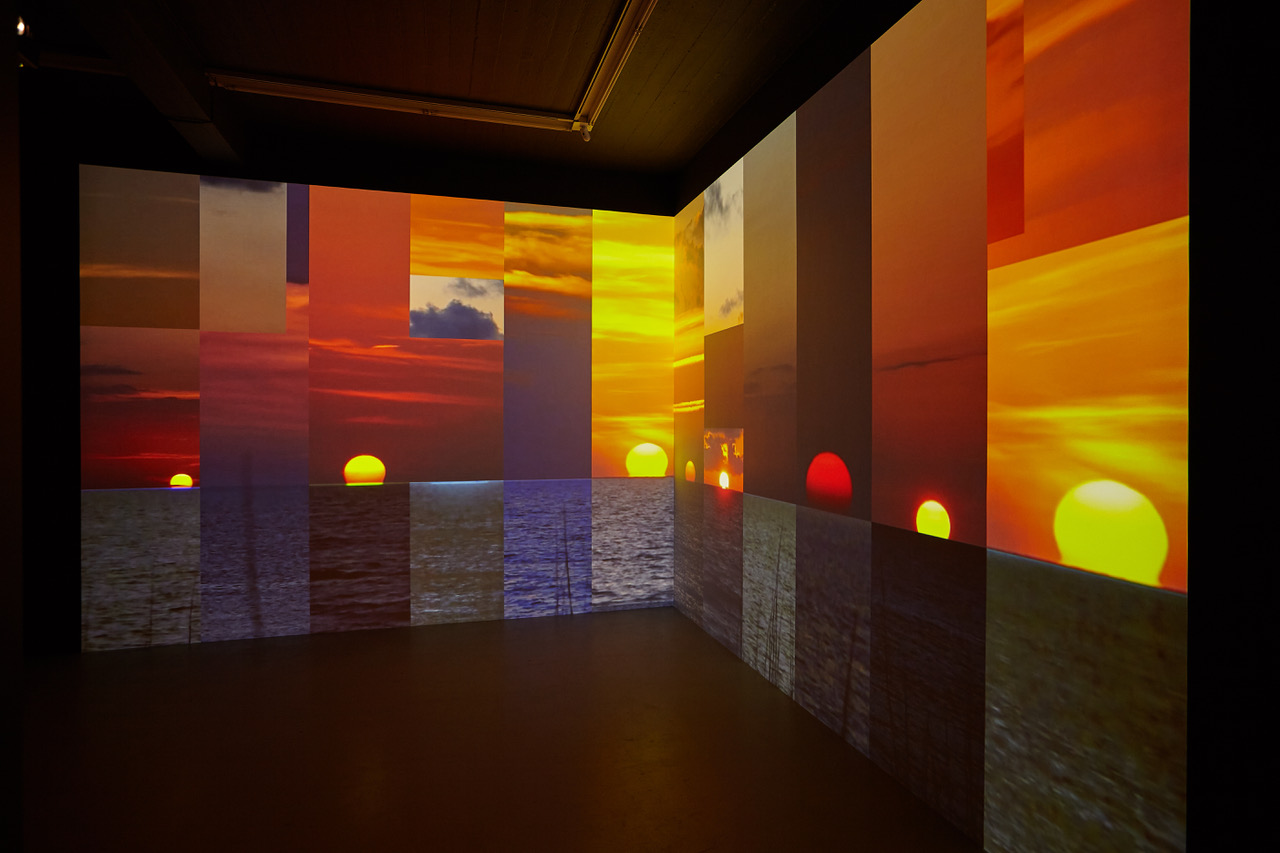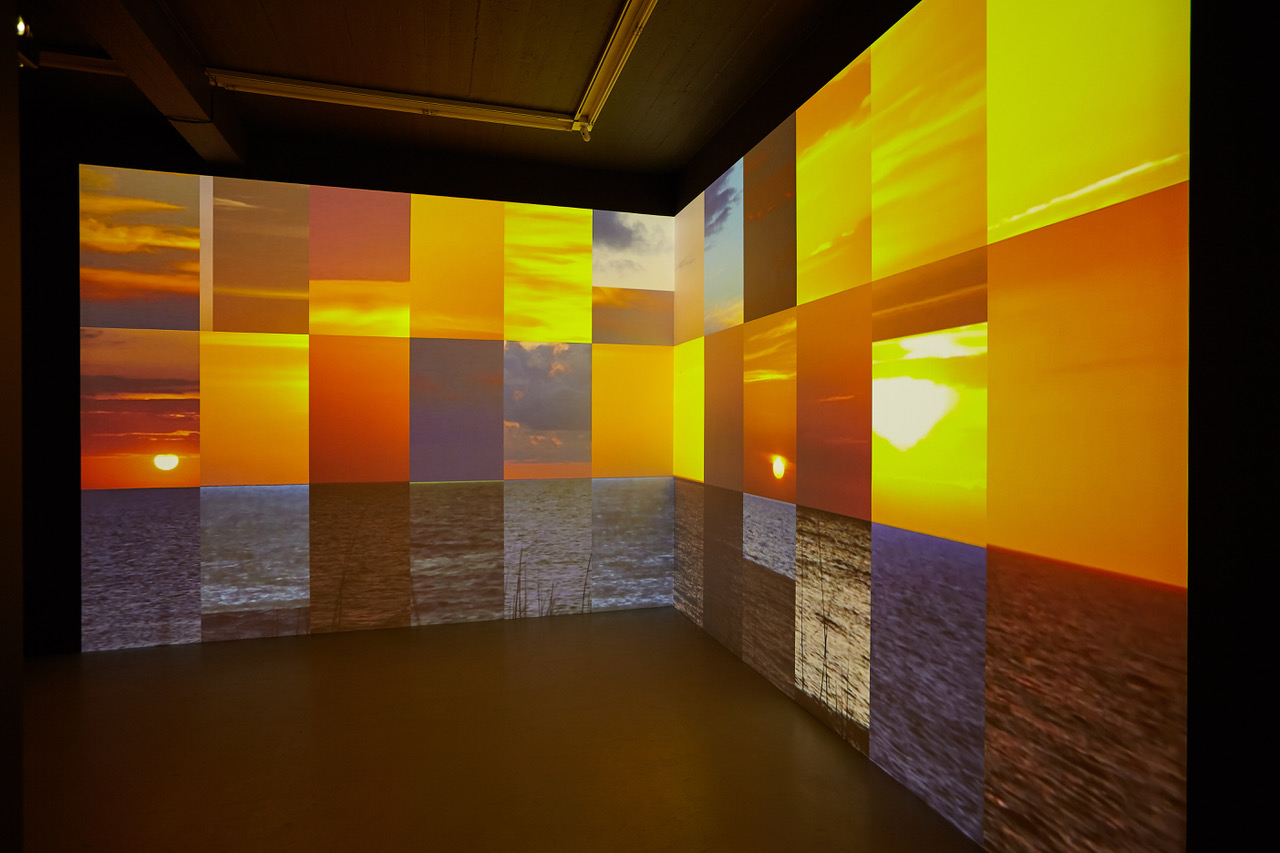
„Kiss the day goodbye“ by Charles Atlas at i8 gallery

„Kiss the day goodbye“ by Charles Atlas at i8 gallery
As the sun disappears from the sky in Iceland, it seems fitting that i8 Gallery should choose an exhibition of this kind to end the year and take us into the new decade. Charles Atlas’s 2015 video installation Kiss the Day Goodbye displays a romanticized vision of the sun, the sea and the sublime. Ironically as I see my own connection with the sun has become that of a long-distance relationship; there is an inherent sentimentality which runs through the video and audio work on display. Concerning the idea of a sun and the memory of how it feels and how these allusions, these false suns, is all that we have left as we move deeper into the winter months.
This video piece differs from many of Atlas’ existing works due to its absence of a performative human body. Its subject instead being that of Florida, the Sunshine State, alongside the Gulf of Mexico which makes up the majority of this American peninsula’s border. It is clear that the sea, sky and sun not only are features that fully encompass the most southerly region of the country but is likewise reverently reflected by Atlas’ use of these three core elements. Arguably it is the latter of these elements, the Sun, which commands the space of the exhibition. It becomes a character in its own right, one which wears many masks and outfits. Not only being cast as an entity of warmth and light. At times it flashes subversive moments of dark coolness through its deep hues paired with the looming twilight skies which surround this figure. The sunset, which signifies the end of our days and the start of our nights, controlling the flow and structure of society since the dawn of time and man, is replicated here 24 times all of which at differing heights and times. A reliable symbol of consistency, Atlas portrays its inconsistency. The work plays with a heliocentric perspective. Snippets of earthly presences, which include kites and birds, flit across sections of the screen to disappear at the border. Shadows would similarly be cast across the wall of the exhibition as car headlights from outside illuminate passing figures who disappear just as suddenly. Nevertheless, nothing seems to compete with the intimidating monument of our star.
The horizon has disintegrated. The limit of the seen world from a given point becomes a void at the end of an ocean. The grid which contains these suns, and numerous seas, similarly have a fracturing effect. Atlas’ implementation of a grid structure as a key motif within the exhibition introduces the audience to his focused portrayal of nature. The black space becoming segmented and numbered as if it were a loading screen counting us down. There are several moments of order which then gradually transition into a patchwork environment as even the grid itself is not bound to an eternal pattern. Instead, these digital edges mimic the border of two domains, cropped images emulating the natural world while also constructing vertical horizons as well. These apparent lines touch and stretch themselves into the other. Shifting and sliding. I cannot help but notice how this movement imitates that of window blinds that reveal and conceal my view of the world and the larger outside. As conversations surrounding borders intensify, especially in the United States, it is refreshing to be confronted by a world where boundaries move and adapt to the surrounding environment. Nothing is set or determined within Atlas’ perspective as edges are no longer defined limits. Sky and sea become fluid as if they are dancing, a give and take which shares the screen. Speaking of the screen, the installation is not even limited to a single wall and instead wraps itself around the corner of the space, extending into multidimensionality which wraps and consumes the viewer.

 Charles Atlas
Charles Atlas
Kiss the Day Goodbye, 2015 (installation view)
two-channel video installation with sound
© Charles Atlas; Courtesy of the artist, Luhring Augustine, New York and i8 Gallery, Reykjavik.
This world of edges, oceans, and endless skylines is filled by a soundscape that evokes a sense of tradition and nostalgia. The audio of a bagpipe playing closes, or maybe opens, the scene like the cockerel cries to the sun as it rises. It’s arguably one of the most recognizable instruments in the western world due to its powerful droning notes that makes an impactful impression within the small space of i8; even masking the passing traffic at times. This instrument alludes to moments of celebration. Often used as a ceremonial element of funerals around the world as this Celtic instrument migrated with its players. In a way, we are asked to attend the funeral of the sun and day as it is buried beneath the waves. Furthering this idea that we, the human race perhaps, are running out of time and an end is approaching. Pondering on how we approach these finalities, considering our innate fear of mortality. Additionally, Atlas has chosen to complement this archaic instrument with a synth soundscape reminiscent of an 80s crime thriller. These minimalist waves of sound become the voice of the scene steadily pulsing its energy into the room. Steady like the setting sun with bursts of industrial squeaks and echoes. Even within this natural landscape the presence of human activity inserts itself. This space is inherently human-made.
It is hard not to consider time while viewing the work in the dark and enclosed gallery space. Evoking ideas of both cosmic and anthropological time. How our perception of these vast planetary movements is almost impossible to register. The digital format and editing of the video allow us to acknowledge our minuscule presence. Our relationship between planetary entities and the human attraction to these distant orbital monoliths. Time and space are used to give ourselves structure and stabilize our position in a universe. There is a balance to it all; fitting since astrologically my sun is a Libra. Important to note is how this presentation of Atlas’ work differs from previous incarnations. Being previously shown in the 2017 Venice Biennale within a larger video/audio installation by Atlas. This included an adjacent digital clock that ran down from 18 minutes, the time it takes the sun to set. I am glad that this countdown clock is absent here. Time resides within ambiguity in this darkened space, a bubble universe where the sun constantly sets. This apocalyptic notion of the end is still present yet less overt, instead of relying on implication and atmosphere. I find there is a hope for a new day as the video resets and the countdown begins again.
The separation of sky and land has fascinated mankind for centuries. The distinction between the heavens and the human world. The mystery of what lies beyond, the intrigue of the unknown. I am intrigued too. I find it ironic that Atlas has, either intentionally or unintentionally, embodied the mythological role of his titanic namesake. A being, who, as the myth goes, was condemned to support the heavens on his shoulders and therefore separate the sky and land for eternity. A responsibility that appears to show signs of degrading and neglect in this shifting exhibition.
George Cox
The exhibition Kiss the Day Goodbye by Charles Atlas runs at i8 Gallery until February the 1st, 2020.
https://i8.is/exhibitions/173/press_release_text/
Cover picture:
Charles Atlas
Kiss the Day Goodbye, 2015 (installation view)
two-channel video installation with sound
© Charles Atlas; Courtesy of the artist, Luhring Augustine, New York and i8 Gallery, Reykjavik.
